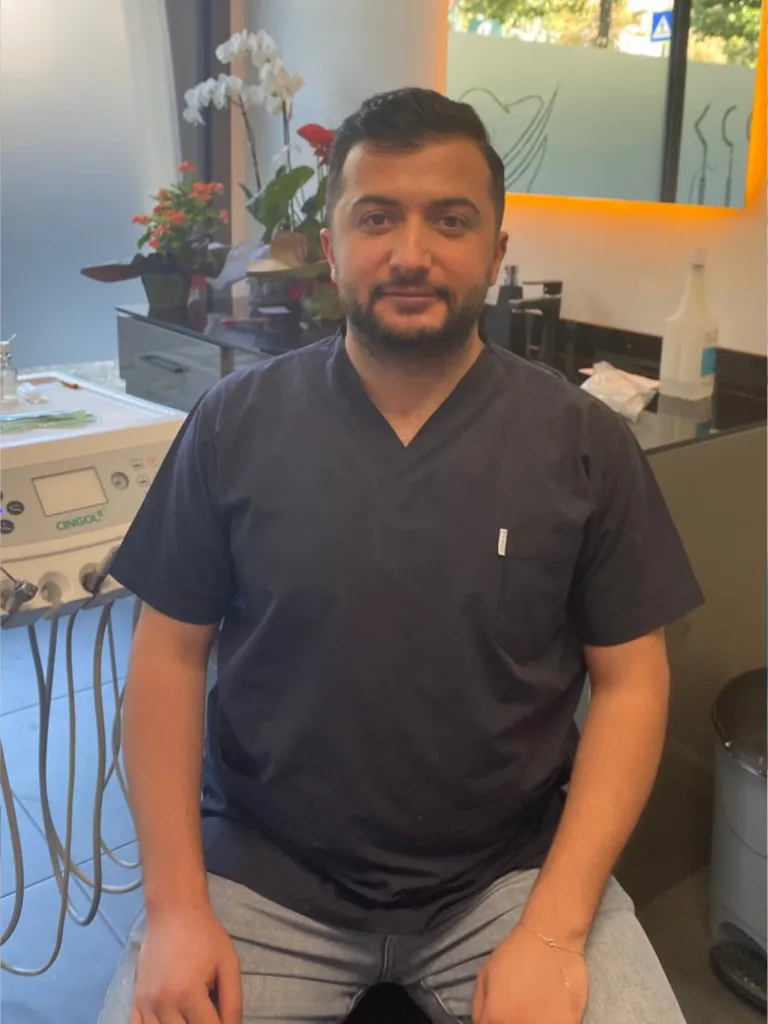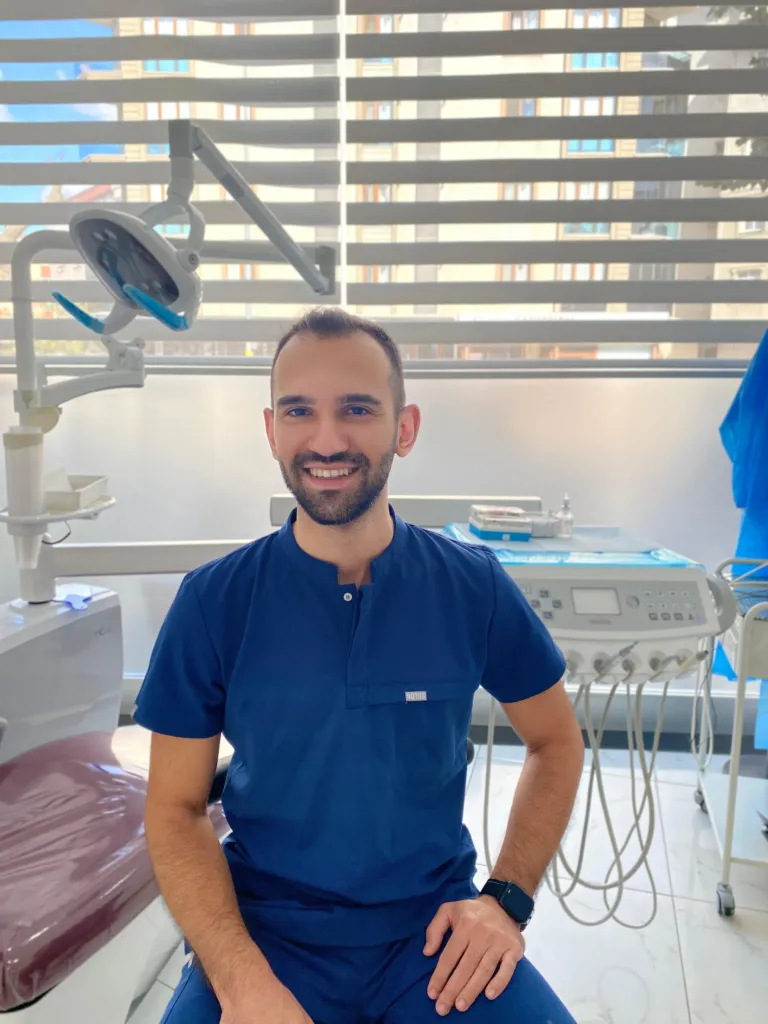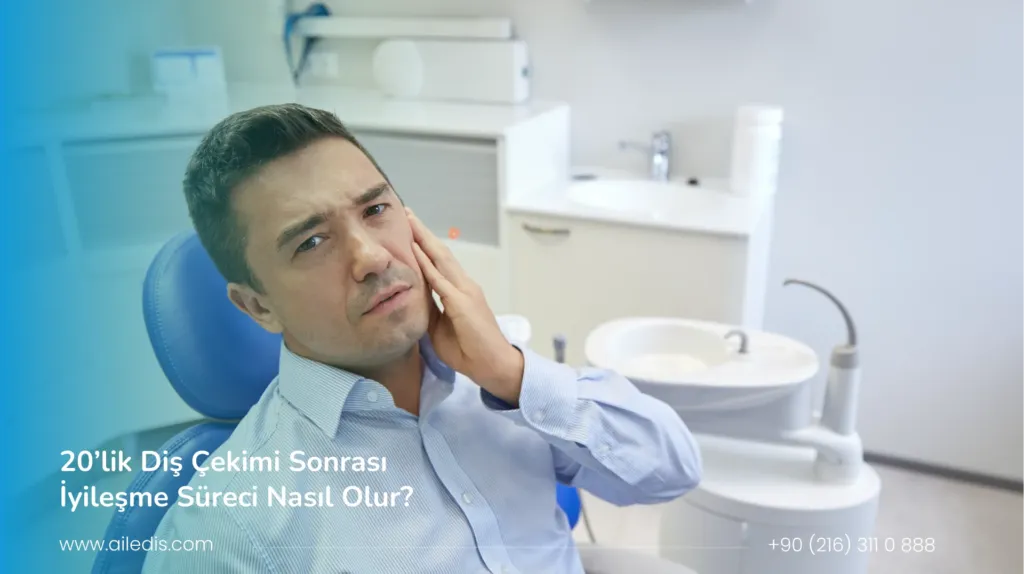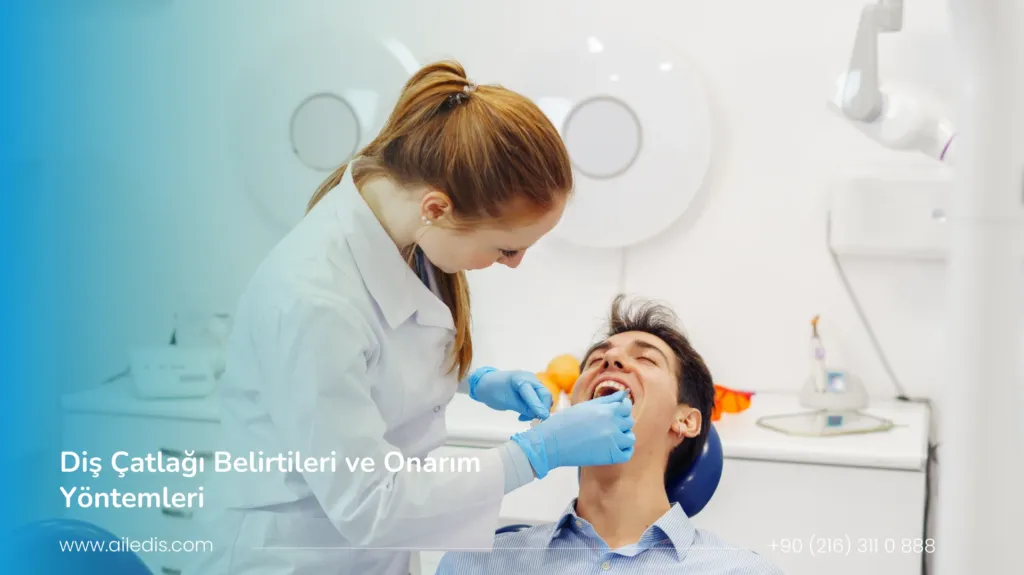dental abscessIt is a health problem that occurs as a result of an infection in the tooth root or gingiva and is usually manifested by severe pain. If left untreated, the infection can progress to the surrounding tissues, even to the jawbone. Therefore, early diagnosis and professional intervention are of great importance.
PRIVATE FAMILY DENTAL CLINICIt offers effective solutions with modern diagnostic methods and sterile clinical conditions in the treatment of dental abscesses. Our expert team implements a personalized treatment plan both to relieve acute pain and to eliminate the source of the infection.
In this article, we will discuss in detail how the dental abscess occurs, what symptoms it occurs with, and what should be considered during the treatment process.
We will also share supportive methods that can help relieve pain at home. For a healthy and painless smile, Under the expert guidance of Family Dent You may begin to become aware of the tooth abscess.
What is a tooth abscess and how does it occur?
Tooth abscess is inflammation that occurs in or around the root of the tooth. It usually occurs as a result of bacterial infections, which causes damage to the nerves or tissues inside the teeth. The formation of the abscess is often associated with caries or gum diseases.
Bacteria enter through the cavities in the tooth, causing infection. An inflamed sac is formed while the body defense mechanisms are trying to activate. This condition can cause pain and swelling; If left untreated, it can lead to more serious health problems.
The formation process of the tooth abscess
Tooth abscess occurs when an infection occurs in or around the root of the tooth. Inflammation begins as a result of bacteria damage to tooth enamel or gums. In this case, while the immune system reacts, an abscess is formed with the accumulation of haze.
With the progression of the infection, the pain increases and the swelling becomes pronounced. If the nerves inside the tooth are affected, this can lead to unbearable pain. The growth of the abscess increases its severity and, if left untreated, can cause more serious health problems.
What causes tooth abscess?
Tooth abscess usually occurs as a result of caries or gum disease in the teeth. Inflammation begins when the bacteria settle in or around the tooth. This situation paves the way for the spread of infection.
In addition, traumas can cause the formation of a tooth abscess. Fracture or cracking of the tooth becomes the gateway of bacteria. The weakened immune system is also a risk factor; In this case, the body struggles with infections more difficult and the development of the abscess becomes easier.
Types of abscesses (periapic and periodontal abscesses)
Dental abscesses appear in two main types: periapical and periodontal. Periapical abscesses are infections that occur in the root of the tooth. They usually develop as a result of tooth decay or trauma. In such abscesses, the pain can be severe and may cause serious problems if not treated.
Periodontal abscesses occur in the gums and surrounding tissues. These infections, which occur due to gingival diseases, are characterized by inflammation. They can cause damage to the support structures of the teeth and cause losses in the future.
What are the symptoms of a tooth abscess?
Tooth abscess is usually manifested by intense and unbearable pain. This pain is felt in or around the root area of the tooth and may increase its severity over time. In addition, this condition manifests itself with symptoms such as swelling and redness of the gums.
Fever, weakness and swelling of the lymph nodes are other common symptoms. All of these symptoms indicate that the body is fighting infection. With the growth of the abscess, discomfort increases, so early intervention is important.
How to detect tooth abscess pain?
Tooth abscess pain is usually felt severely and sharply. This pain is concentrated around the tooth and sometimes increases during chewing. In addition, discomfort may increase with the consumption of hot or cold foods.
Other symptoms of the presence of the abscess include tenderness and pressure in the gums. Sometimes the pain can spread to the head or neck area, making the condition more complex. It is important to consult a dentist; It requires treatment without wasting time.
Symptoms of gum swelling and redness
Gingival swelling is one of the most prominent symptoms of tooth abscess. It occurs as a result of inflammation of the gums and is often accompanied by pain. Swelling creates a feeling of discomfort inside the mouth and can sometimes make it difficult to eat.
In addition, redness of the gums is observed. This indicates that the inflammation increases. The reddened area becomes sensitive and the risk of bleeding increases. If these symptoms are noticed, it is important to consult a dentist without wasting time.
Fever, weakness and lymph node swelling with a tooth abscess
A tooth abscess can cause fever, the body’s way of fighting infection. The presence of the abscess leads to inflammation in the body with the activation of the immune system. This situation creates a general feeling of weakness and can make the individual’s daily activities difficult.
Swelling in the lymph nodes can also be observed. The lymph nodes are areas where cells that fight infection are stored, and therefore they can grow and cause discomfort in cases such as a dental abscess. Swollen lymph nodes often also cause pain.
What happens if the dental abscess is not treated?
If the dental abscess is left untreated, the progression of the infection can lead to serious and permanent health problems. The abscess is a bacterial inflammation that occurs in the root of the tooth and can spread to the surrounding tissues over time. This situation, bone infection, , Tooth loss and even jawbone damage may cause complications such as
PRIVATE FAMILY DENTAL CLINIC According to experts, a dental abscess can affect the health of the whole body, not just in the mouth. If the infection is left untreated, it can reach vital organs by mixing with the bloodstream. Therefore, when a dental abscess is noticed, it is of great importance to consult a dentist without delay.
Does the tooth abscess spread to the brain or blood?
An untreated tooth abscess, Bacteria mixing with blood may cause. This can lead to life-threatening systemic infection called sepsis. The infection spreads faster, especially in individuals with weak immune systems.
Bacteria that reach the brain meningitis or cerebral abscess can cause serious complications such as Such situations require immediate medical attention. The following table summarizes the possible consequences of untreated tooth abscesses:
| Type of complication | affected area | probable outcome |
| Bone infection (osteomyelitis) | jawbone | Persistent tissue loss, tooth loss |
| sepsis | The blood circulation | Life-threatening, multiple organ failure |
| Brain abscess / meningitis | brain tissue | Neurological damage, high fever |
| Heart valve infection (endocarditis) | False | Risk of persistent heart damage |
This table clearly shows how critical early treatment is.
Risks of untreated abscesses
Infection progresses if the dental abscess is left untreated jawbone, gingival and surrounding muscle tissues effects. This situation negatively affects not only dental health, but also general health.
In addition, chronic abscesses can cause constant pain, weakness and fever. This picture reduces the quality of life and surgical intervention may require. When swelling and temperature increase are noticed, especially in the face area, physicians should be consulted immediately.
Chronic tooth abscess results
Chronic tooth abscesses become a source of long-term infection. In this case, there is a constant inflammation in the root of the tooth and the surrounding tissues are damaged over time.. Tooth loss, , jawbone stenosis and facial asymmetry such problems may develop.
Also, chronic infection weakens the immune system. Since the body is in a state of constant defence, fatigue, fever and a decrease in general health can be observed. In the long run, the risk of complications increases in organs such as the heart and kidneys.
Dental abscess treatment methods
Dental abscess treatment is planned according to the size of the infection. The goal is to eliminate inflammation and protect the tooth if possible. Usually one or more of the following methods are applied:
- Root canal treatment: The internal structure of the infected tooth is cleaned, the ducts are disinfected and the filling is performed.
- Antibiotic use: If there is a risk of spread, the infection is controlled.
- Surgical intervention: In large abscesses, inflammation is drained or tooth extraction may be required.
Since the condition of each patient is different, the treatment plan is prepared individually.
Dental abscess treatment with root canal treatment
root-stockIt is one of the most effective methods in the treatment of dental abscesses. The nerves and vessels in the inner part of the tooth are removed and the infected tissue is cleaned. This process both reduces pain and prevents the spread of infection.
Relief is felt within a few days after treatment. However, regular dental check-ups should not be neglected after root canal treatment. This ensures the longevity of the tooth and prevents the formation of re-infection.
Use of drugs and antibiotics for dental abscesses
Treatment of dental abscesses antibioticsIt is often prescribed to control the infection. However, these drugs should be used only under the supervision of a physician. Self-medication can lead to the development of resistance and inadequate treatment.
Pain relievers also provide temporary relief, but do not replace the actual treatment. PRIVATE FAMILY DENTAL CLINICprovides detailed guidance to its patients on the correct dose, duration and type of medication in the use of antibiotics and painkillers.
Situations requiring surgical intervention
In some cases, a dental abscess may require surgical intervention. If the infection is out of the root of the tooth or if the abscess has become a large mass, the tooth may need to be extracted or the abscess be drained.
After surgery, the infection is controlled with appropriate antibiotic treatment. In addition, regular oral hygiene and controlled eating habits accelerate the healing process.
Abscess tooth extraction and timing
Tooth extraction with abscesses may be necessary to maintain the health of infected teeth. This procedure should be scheduled depending on the condition of the abscess and the general health of the patient. The dentist recommends performing the shooting after making sure that the inflammation is under control.
It is also a frequently preferred approach to apply antibiotic treatment before tooth extraction. In this way, the risk of infection is reduced and the healing process is accelerated. It is important to get expert opinion in order to determine the most suitable time to have the abscessed tooth extracted.
Is abscessed tooth extracted?
Tooth extraction with abscess is an important step in the treatment process. However, this process should be carefully planned, as the inflammation needs to be controlled. Your dentist may first apply treatments to reduce inflammation to prevent the spread of infection.
When the tooth is required to be extracted, appropriate timing is usually made depending on the condition of the abscess. The physician can safely extract the tooth after checking the infection. In this process, the patient’s comfort is ensured by using anesthesia and the healing process is made fast.
Control of inflammation before tooth extraction
Controlling inflammation before tooth extraction is a critical step to prevent complications. Inflammation can cause swelling and pain in the gums and surrounding tissues. Therefore, physicians often recommend antibiotic therapy.
The use of antibiotics accelerates the healing process while preventing the spread of infection. In addition, painkillers may also be prescribed depending on the patient’s condition. This preparatory stage before tooth extraction is important for a successful intervention.
Follow-up and recovery process
Following tooth extraction is one of the most important stages of recovery. Following the doctor’s recommendations in this process reduces the risk of infection and accelerates healing. It is important to rest in the first days and keep the head up if possible.
In addition, gauze may be required for several hours to control bleeding after tooth extraction. It is also useful to apply cold compresses to prevent swelling. Pain in the recovery process is normal; However, if this situation lasts for a long time, a doctor should be consulted.
How to relieve a tooth abscess at home?
The discomfort caused by the tooth abscess can be relieved at home with several methods. Gargling with salt water can be an effective way to reduce pain. This procedure helps to reduce inflammation and ensure oral hygiene.
Applying cold compresses is also useful to relieve swelling and pain. You can achieve temporary relief using painkillers; However, care should be taken to use these drugs without overdoing it. Home interventions offer a temporary solution and professional help should be sought.
Dental abscess salt water mouthwash and cold compress application
Salt water mouthwash is an effective method to relieve the symptoms of dental abscesses. Gargling with a mixture obtained by dissolving a teaspoon of salt in a glass of warm water reduces the bacteria in the mouth and calms the inflammation. This application can be repeated several times a day.
Cold compress is used to reduce swelling. Wrapping the ice bag with a thin cloth and placing it on the aching area both relieves the pain and prevents the formation of swelling by slowing down the blood flow. It is important to apply both methods carefully and regularly.
Pain relief use and limitations
In the case of a tooth abscess, painkillers are frequently used to relieve discomfort. Commonly used drugs include ibuprofen and acetaminophen. These drugs can help relieve pain by reducing inflammation. However, excessive use of such drugs can cause some side effects.
Pain relief treatment is only a temporary solution. Does not solve the problem underlying the tooth abscess; Therefore, a professional dentist should be consulted. Prolonged or high-dose use can cause liver and kidney problems.
Risks of blasting tooth abscess at home
Exploding a tooth abscess at home brings with it many risks. This method can often worsen the condition by spreading the infection even more. While the inflammation inside the abscess is discharged, bacteria can pass into the surrounding tissues and blood.
Also, this self-inflicted intervention can increase pain and lead to severe complications. If the infection is not controlled, serious health problems may develop. It is the best approach to get help from a specialist for the treatment of dental abscesses.
Does tooth abscess recur? What should be done to prevent it?
Dental abscess may recur if not treated properly. Especially if oral hygiene is not taken care of, the risk increases. It is possible to prevent abscesses with regular tooth brushing, flossing and periodic dentist controls.
Bruises and gum infections should be treated quickly. If these situations are intervened before they progress, the probability of experiencing bigger problems is reduced. Lifestyle changes are also beneficial for a healthy mouth structure! It is important to eat a balanced diet and drink enough water.
The importance of regular oral hygiene and controls
Regular oral hygiene plays a critical role in preventing dental abscesses and other oral health problems. Basic habits such as tooth brushing, flossing and mouthwash prevent plaque formation. Thanks to these applications, the risk of gum diseases is reduced.
In addition, regular dental check-ups are also of great importance. Early diagnosis is possible with examinations performed by experts. Thus, potential problems can be treated before they grow. You can relax for a longer period of time by taking care of your oral health.
Early treatment of caries and gum infections
Caries and gum infections are the most common causes of dental abscesses. Early treatment of these problems can prevent serious health problems. Thanks to the detection of caries and the necessary intervention during dentist checks, pain and aesthetic concerns that may be experienced in the future are minimized.
Inflammations on the gums should also not be neglected. Maintaining gum health is essential to prevent the spread of infection. Such problems can be prevented by using regular brushing and flossing.
Tooth abscess treatment process in Private Family Dental
The dental abscess treatment process in Private Family Dental begins with the evaluation of a specialist physician. First, the patient’s condition is examined in detail. After the examination, the necessary examinations are made and the risk of spreading the infection is determined.
The treatment plan is prepared individually and shaped according to the needs of the patient. In this process, methods such as root canal treatment or surgical intervention can be applied. After the treatment, the recovery process is closely monitored with regular follow-up and support programs.
Specialist physician evaluation
Specialist in dental abscess treatment evaluation is of great importance. Your dentist will do a detailed examination by listening to your complaints. It determines the size and source of the infection with imaging methods such as x-rays.
This assessment plays a critical role in the creation of the appropriate treatment plan. A specialist physician can accelerate your healing process by offering the most correct approach to your dental health. Thus, possible complications are minimized.
Personalized treatment planning
Personalized approaches in the treatment of dental abscesses take into account the needs of each individual. Since each patient’s condition is different, the treatment process is shaped accordingly. Your dentist will determine the most appropriate method according to your age, general health status and the prevalence of the infection.
A detailed examination is important in this process. The inner structure of the tooth is examined with x-rays taken after the examination. Thus, both the problem area is detected and an effective treatment plan is created. Considering individual needs, it is aimed to achieve a healthy result with the recommended methods.
Post-treatment follow-up and support program
Following dental abscess treatment, patients’ recovery period should be followed closely.. Post-treatment checksis of great importance so that the infection does not recur. Specialist dentists recommend regular appointments to evaluate the patient’s condition and create the necessary support program.
In addition, the patient should pay attention to oral hygiene in this process and monitor his symptoms. When any discomfort is felt, a doctor should be consulted immediately. In this way, the problem is detected at an early stage and more serious health problems are prevented.
Individual treatment plans are created to prevent recurrence of dental abscesses. It should not be forgotten that the situation of each individual is different; Therefore, the personalized approach will bring the most effective results.







Dental abscess frequently asked questions
How does a tooth abscess heal?
A tooth abscess can only be completely cured with dental intervention. Usually, the infection is drained and antibiotic treatment is administered. Then, if necessary, root canal treatment or tooth extraction is performed.
Can a tooth abscess be drained at home?
No, it should never be popped. This can cause the infection to spread and lead to serious complications. You should see a dentist as soon as possible.
Can a wisdom tooth be extracted?
During the acute phase, when the inflammation is active, extraction is generally not performed. First, the infection is brought under control, and then, if necessary, tooth extraction is performed.
What helps with tooth abscess pain?
A saltwater gargle and cold compress may provide temporary relief. However, professional treatment is required for a definitive solution.
Does a tooth abscess recur?
If the infection in the tooth root is not completely cleared or the root canal treatment is incomplete, the abscess may recur. Regular check-ups reduce this risk.
Can a tooth abscess heal without antibiotics?
No, in most cases antibiotic support is required. However, medication alone is not sufficient; the source of the abscess must be treated by a dentist.
Can root canal treatment be performed on a tooth with an abscess?
Yes, root canal treatment can be performed by cleaning the infected tissue that causes the abscess. This prevents the tooth from being extracted.
Does a tooth abscess cause swelling in the face?
Yes, especially in cases of lower jaw abscesses, noticeable swelling may occur on one side of the face. This situation requires urgent intervention.







